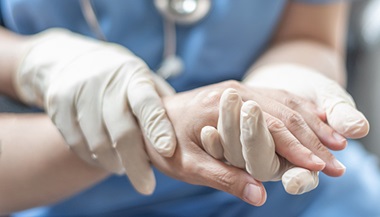Brachydactyly (Short Fingers or Short Toes)
What You Need to Know
- A short small finger or clubbed thumb are the most common brachydactyly types.
- Short fingers or short toes may affect appearance, but brachydactyly rarely affects function or movements.
- Most people with brachydactyly do not need treatment.
What is brachydactyly?
Brachydactyly (brack-ee-DACK-til-ee) causes certain digits to be shorter because the bones in the affected digits don’t grow as long as they should. “Brachy” means short; “dacytlos” refers to digits. Brachydactyly fingers, a type of congenital hand difference, are more common than brachydactyly toes.
Brachydactyly Types
The affected bones and their location in the hand or foot determine the type of brachydactyly. Brachydactyly types include:
Type A (Brachydactyly Fingers)
With brachydactyly type A, the bones in an affected finger do not grow as they should. There are different subtypes depending on which fingers are short. Most people have brachydactyly type A3, which causes a short small finger. Sometimes, all fingers or only the index finger are short.
Type B
Brachydactyly type B causes short fingers (except the thumb) or short toes (except the big toe). The bones in the tips of the affected digits are shorter than usual or missing.
Type C
Brachydactyly type C causes short index, middle and little fingers. This type affects growth in the affected fingers’ middle bones.
Type D (Clubbed Thumb)
Brachydactyly type D affects bone growth at the thumb tip, causing a short thumb. Other names for brachydactyly type D include:
- Brachydactyly thumb
- Clubbed thumb
- Hammer thumb
- Stub thumb
- Toe thumb
Type E
Brachydactyly type E causes a short, clubbed thumb and a short, big toe. It affects the growth of bones in the hands (metacarpals) and feet (metatarsals). These bones connect to the digits.
Symbrachydactyly
Symbrachydactyly is a related condition that resulting in short, missing or stiff digits. The “sym” part of the word means joined. Some of the affected digits fuse together, creating a webbed appearance known as syndactyly. For most children, symbrachydactyly affects only the left hand.
What causes brachydactyly?
Several gene changes (mutations) cause the different types of brachydactyly. The mutated gene affects bone growth. Some people inherit this changed gene, which is why the condition can affect multiple members of the same family. The gene change can also occur spontaneously for no apparent reason.
Certain syndromes and conditions increase the risk of brachydactyly. These conditions include:
- Brachydactyly-mesomelia-intellectual disability-heart defects syndrome
- Craniofacial abnormalities, such as Apert syndrome
- Down syndrome (trisomy 21)
- Robinow syndrome
- Rubinstein-Tabi syndrome
- Short stature
- Turner syndrome
How common is brachydactyly?
Isolated brachydactyly that is not associated with another condition is rare. Brachydactyly type A3 (short little finger) and brachydactyly type D (clubbed thumb) are the most common. Still, these conditions are rare. They affect about 2% of people.
How is brachydactyly diagnosed?
Short fingers or short toes may be noticeable at birth or become evident during childhood. An X-ray and gene test (type of blood test) can determine the brachydactyly type.
Brachydactyly Treatments
Brachydactyly rarely affects a person’s ability to use their fingers and hands (or toes and feet). For this reason, most people do not need treatment. If treatment is needed, it may include:
Physical and Occupational Therapy for Brachydactyly
Physical therapy, occupational therapy and hand therapy can help improve function and mobility.
Brachydactyly Surgery
For some people, plastic and reconstructive hand surgery may improve how the digits look and function. These procedures include:
- Osteotomy to cut bone and gradually lengthen short fingers
- Bone grafting and osteotomy to lengthen and reshape a short thumb
- Moving bone from a toe to a finger to increase length or moving bone from a toe to a thumb to allow it to grip objects (free phalangeal transfer)
Symbrachydactyly Surgery
Surgery to treat symbrachydactyly usually takes place when a child is between 1 and 2 years old. Some children need more than one surgery. Depending on the type, surgery may involve:
- Releasing tissue or skin flaps to help a child grab and pick up items
- Separating skin, soft tissues or bones that fuse the digits together
- Surgically lengthening bones
- Transferring a toe to the affected hand (which does not affect a child’s ability to walk or move their feet)
Living With Brachydactyly
Brachydactyly is typically a cosmetic limb difference that affects appearance, but not function.
Most people with brachydactyly can use their digits, hands and feet the same as those who do not have the condition.






